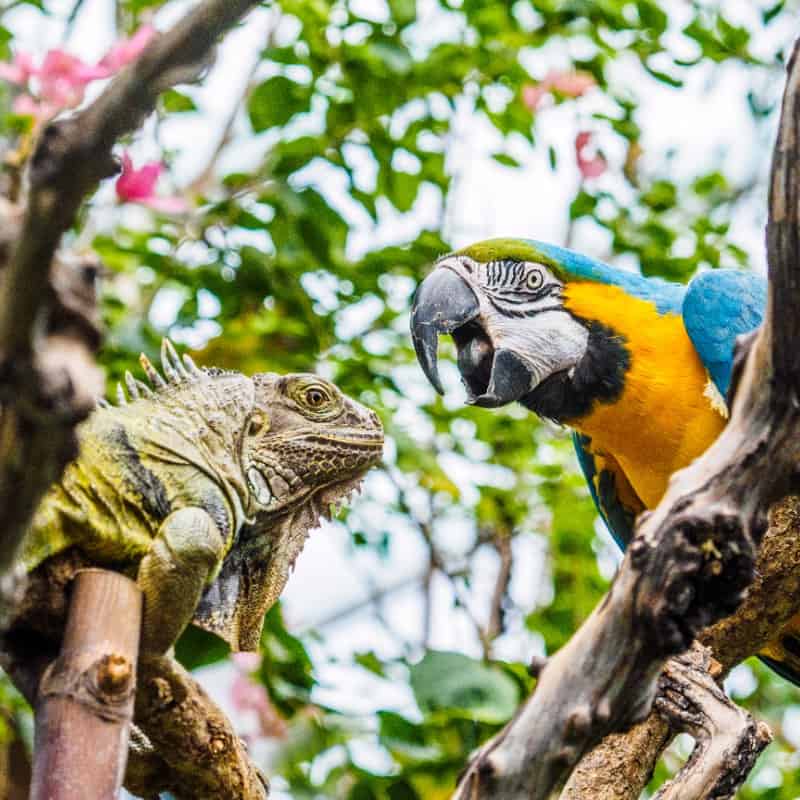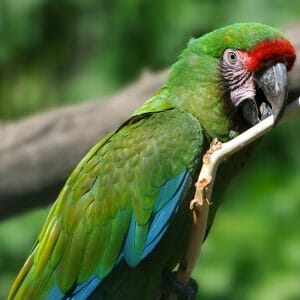
Why Don’t Parrots Understand the Word “No”?
Last Updated on by Mitch Rezman
Greetings, fellow parrot enthusiasts! Today, we dive into the fascinating world of our feathered friends and uncover the mysteries behind their understanding (or lack thereof) of the word “no.” We all know that parrots can sometimes exhibit bad bird behavior or present us with bird behavioral problems.
So, why is it that our lovable companions seem oblivious to the concept of “no”? Let’s explore this intriguing phenomenon together!
When it comes to communication, parrots have a unique way of interpreting our words. While they may not grasp the inherent meanings of most words, they are masters at making associations based on context. Picture this: your parrot greets you with a cheerful “How are you?” when you enter the room. But don’t be fooled! It’s not because they genuinely care about your well-being. Instead, they have cleverly associated those words with your presence.
Parrots are renowned for their impressive mimicry skills, effortlessly imitating various sounds, including spoken words. However, while they may mimic their owners, the majority of parrots don’t truly comprehend the meaning behind what they’re saying. Yes, there are exceptional cases like Alex, the African Grey Parrot, who showcased an astonishing ability to understand and utilize language to some extent. But, let’s be honest, such cases are as rare as finding a feather in a haystack.
Now, you might wonder, “Why don’t parrots understand human language like we do?” Well, it all boils down to anatomy. Parrots lack vocal cords akin to ours, but they cleverly utilize the muscles in their throat to direct air over the trachea, producing an array of captivating sounds. But how does this affect their comprehension of the word “no”? Let’s unravel the contextual understanding of “no” for parrots in our next section.
The Contextual Understanding of “No” for Parrots
Parrots are known for their ability to mimic human speech and sounds, but do they truly understand the meaning behind the words? When it comes to the word “No,” the answer lies in the context in which it is used.
Animals, including parrots, don’t inherently understand the exact words we say or the tone of our voice. Instead, they rely on their exceptional ability to decipher context and understand contingencies. When a parrot hears “No” in the context of it engaging in undesirable behavior, it may associate the word with something negative or aversive happening next.
This association can lead the parrot to avoid that behavior in the presence of the word “No,” but it may not fully comprehend why the behavior is undesirable. As such, using positive reinforcement-based cues, such as redirecting the parrot to a more desirable activity, can be a more effective approach to behavior modification.
The Problems with Aversive-based Training
When it comes to training parrots, using aversives such as yelling or physical punishment might seem like a quick solution to stop unwanted behavior. However, these methods can have serious negative consequences on both the overall behavior and well-being of the parrot. Aversives can increase stress and aggression in parrots, leading to more problem behavior such as biting, screaming, and feather destructive behavior.
Using aversives as the primary means of training can also result in avoidance-based solutions where the parrot only avoids the behavior when the trainer is present. This does not address the underlying cause of the behavior and can strain the relationship between the parrot and its owner. It’s important to remember that parrots are extremely intelligent creatures with complex emotions, and they respond much better to positive reinforcement-based training methods.
The Benefits of Positive Reinforcement
By focusing on positive reinforcement-based training methods, we can effectively address behavior problems in parrots while also strengthening the bond with our feathered friends. Positive reinforcement involves rewarding the parrot for desired behaviors, such as using a clicker and giving treats when the parrot displays good behavior. This approach creates a positive association and motivates the parrot to repeat the desired behavior.
Additionally, providing parrots with alternative, more desirable activities can help redirect their energy and reduce stress. For example, if a parrot tends to exhibit aggressive behavior when it’s bored, providing it with puzzle toys or interactive foraging activities can keep it mentally stimulated and engaged.
In conclusion, using aversives to train parrots can have detrimental effects on their well-being and behavior. Instead, we should focus on positive reinforcement methods and providing them with enriching activities to promote their overall welfare. By taking a more empathetic and understanding approach, we can create a harmonious and enjoyable relationship with our parrots.
Parrots’ Cognitive Abilities in Language Understanding
Parrots, particularly African Grey Parrots, possess remarkable cognitive abilities that allow them to understand and utilize human language to a significant extent. Research has revealed that parrots have distinct brain regions dedicated to mimicry, similar to those found in the human brain.
In fact, parrots with a higher aptitude for mimicry exhibit more pronounced brain regions associated with this skill. While the full extent of their language comprehension is still a subject of debate, there is evidence to suggest that parrots can make associations, answer questions, and even label objects and events using their vocalizations.
Parrots’ language abilities have evolved as a means of communication within their social groups, and their cognitive prowess is comparable to that of primates. They possess the capacity to understand and respond to various vocal cues, demonstrating their advanced cognitive capabilities.
While parrots may not possess a complete understanding of human language in the same way that humans do, their ability to make connections and utilize vocalizations for communication purposes is truly unique.
The understanding of parrots’ cognitive abilities extends beyond simple mimicry. These intelligent birds can comprehend contextual cues, answer questions, and engage in limited conversations.
Their proficiency in vocal learning and mimicry enables them to establish and maintain social bonds both in the wild and in captivity. Understanding and appreciating parrots’ language understanding can significantly enhance our interactions with these fascinating creatures and enable us to build stronger connections with them.
The Natural Purpose of Vocalization in Parrots
Parrots, those clever and charismatic birds, have a natural talent for vocalization. Just like other bird species, they use their vocalizations to communicate with their group or flock. It’s their way of establishing territory, attracting mates, sounding the alarm, and identifying one another. Vocal learning and mimicry are vital skills for wild parrots to thrive in their natural habitats.
In captivity, parrots form bonds with their human keepers by imitating human vocalizations and seeking attention and rewards. While they may not fully comprehend the context of human language, they can still make associations and use vocalizations as a means of communication. It’s fascinating to witness their ability to mimic human speech and sound effects, which is a testament to their advanced cognitive abilities.
So, how can we leverage this natural vocalization behavior in parrot training? Here are a few bird training tips to better understand your feathered friend’s communication:
- Pay attention to the various vocalizations your parrot makes and try to recognize their different meanings or intentions.
- Observe their body language and context when they vocalize, as this can provide valuable insight into their current emotional state or needs.
- Respond positively and reward the desired vocalizations to reinforce their use, while redirecting or ignoring undesired ones.
- Engage in interactive play sessions using vocal cues to strengthen your bond and provide mental stimulation for your parrot.
By understanding and respecting the natural purpose of vocalization in parrots, we can establish a stronger connection and create a more enriching environment for our feathered companions. So let’s embrace their unique abilities and engage in meaningful communication with these remarkable avian creatures.
Written and Approved by the Windy City Parrot Content Team
Author Profile
Latest entries
 The Traveling BirdJune 26, 2025Can You Name 5 Parrot Species That Are Living Wild in the USA?
The Traveling BirdJune 26, 2025Can You Name 5 Parrot Species That Are Living Wild in the USA? Bird BehaviorJune 26, 2025How is it Parrots Are Problem Solvers Social Animals and Even Use Tools?
Bird BehaviorJune 26, 2025How is it Parrots Are Problem Solvers Social Animals and Even Use Tools? Bird & Parrot AnatomyJune 25, 2025How a Tiny Chemical Modification Makes Parrots Nature’s Living Paintings
Bird & Parrot AnatomyJune 25, 2025How a Tiny Chemical Modification Makes Parrots Nature’s Living Paintings PigeonsJune 20, 2025How Do Parrots Thrive in Cities Outside Their Native Habitats?
PigeonsJune 20, 2025How Do Parrots Thrive in Cities Outside Their Native Habitats?


